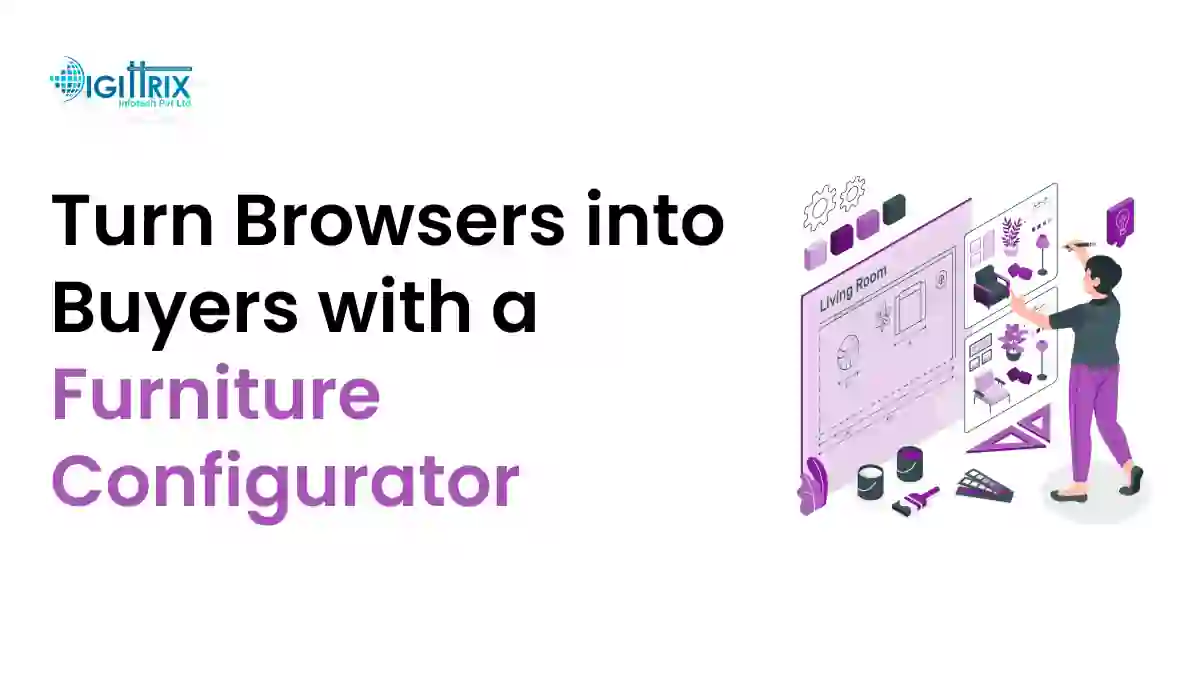Build a custom furniture configurator using 3D tools to increase sales, reduce returns, and offer personalised shopping experiences that meet today's customer expectations.
Highlights
An enthusiastic developer and skilled business management expert with over a decade of experience in the field

In the modern furniture market, businesses must keep up with growing customer expectations for convenience, customization and speed. Buyers today are no longer satisfied with standard options and long wait times. They want to see their ideas come to life before they make a purchase. This is where a furniture configurator becomes valuable.
A furniture configurator is a digital tool that allows users to design, modify and visualize furniture according to their needs and preferences. When created with precision, it can increase customer satisfaction, shorten decision-making time, and help businesses stand out from competitors.
This article explains how to develop a furniture configurator that not only meets current user expectations but also helps businesses improve their sales performance. The Invesp report shows that 60% of online shoppers prefer websites offering product personalization features.
A furniture configurator works as an interactive tool that lets users change things like the materials, colors, shapes, sizes, or extras for furniture. Many of these platforms include 3D furniture configurator technology to give a clear picture of how the selected options will appear.
The main idea is to create a simple way for customers to design the product they want and see it as they go. This helps clear up confusion and makes people more confident when buying. Businesses can use this system on websites or through mobile app development services.
Looking for the right IoT partner? Explore the top 10 IoT app development companies in India to bring your ideas to life!
When you invest in a custom furniture configurator, you allow customers to personalize pieces in ways that standard catalogues don’t offer. Below are several benefits of offering this option:
Visual Clarity: By using a 3D furniture configurator, users can see exactly what they are purchasing. This minimizes confusion and lowers return rates.
Increased Purchase Confidence: When people have a clear visual of their custom product, they feel more certain about their choices.
Higher Conversion Rates: When customers engage with an interactive product tool, they tend to stay longer on the site, increasing the chance of making a sale.
Cost Reduction for Prototypes: Companies don’t need to build physical models for every variation, saving time and money.
Data Collection: Customer preferences collected through the configurator can guide future product planning.
If you want to create a furniture configurator, aim to design something useful, precise, and easy to use. Below are the main features to include:
Users should be able to tweak things like materials, colors, sizes, leg shapes, cushions, and other details. The tool needs to reflect changes right away as users adjust.
A 3D furniture configurator shows the furniture from every angle. Real-time rendering with options to zoom in or rotate lets buyers inspect their picks more.
Give people the ability to explore different textures, finishes, patterns, and wood types. Including previews or fabric swatches makes this part much more effective.
Let customers resize products to match their spaces. Accurate measuring tools make this process more reliable for them.
Make every size or material change show the updated cost right away. Showing prices in real time builds trust with users.
Give people the option to save their designs and share them over email or on social media. This helps when buyers want input from family or designers.
Add AR so users can see how furniture looks in their rooms using their phones. This gives a better sense of how it fits and helps decision-making.
To develop a solution that works efficiently, you need an app development company with experience in furniture configurator development and custom software development. Such a company should understand not just how to code, but also how furniture buying habits influence app features. 3DCloud research reveals that 3D product configurators can reduce return rates by up to 80% for retailers.
Ask the development team about:
Their experience with 3D modelling
Integration of e-commerce features
Past projects related to furniture or retail
Their process for testing on multiple devices
Support for web, tablet, and mobile use
Partnering with an experienced company ensures that your configurator runs smoothly, loads quickly, and remains accurate during usage.
Many users browse and shop using their phones. That’s why investing in mobile app development services for your configurator is a smart step.
The mobile version should:
Be lightweight yet functional
Support touch-based design interactions
Include AR functionality if possible
Offer a quick checkout process
A strong mobile experience makes the tool more accessible, allowing customers to design and order furniture from anywhere.
Once the configurator is ready, you should connect it to your online store or ordering system. Users should be able to:
Add customized items to the cart
View product details and pricing
Choose shipping or pickup options
Make payments directly
Inventory systems can also be connected to provide real-time stock updates based on selected configurations. If you’re building the tool from scratch, custom software development allows you to link these components efficiently.
Furniture configurators can also be developed as part of on-demand app development. On-demand furniture apps help users get personalized furniture designed and delivered quickly.
Adding configurator tools to an on-demand app gives users the ability to:
Choose designs
Book consultations
Place orders
Track production and delivery
This format works well for furniture makers who produce items as per customer request rather than from a fixed inventory.
Here’s a simple step-by-step method to begin furniture configurator development:
List all products you want to include and the customization options for each. Start with a few popular pieces to keep it manageable.
Work with designers or 3D modelling experts to create accurate visual representations of each item. Ensure the models are optimized for performance.
This engine handles the logic of combining various selections. It must be built in a way that combinations are correctly rendered.
Create a front-end interface where users can interact with the configurator. Prioritize simplicity and clarity.
Set up real-time pricing updates and link the tool with your store’s checkout system.
Test your configurator on mobile phones, tablets, and desktops. Check for bugs, speed, and visual accuracy.
After testing, launch your configurator and spread the word through email, social media, and your store website.
Several well-known furniture brands use configurators successfully. Here are a few ideas you can draw inspiration from:
Modular Sofas: Let customers choose different seating sections, upholstery types, and arrangements.
Dining Tables: Users can adjust size, choose tabletop finishes, and select leg types.
Shelving Units: Allow height, width, and compartment customization.
By studying existing tools, you can find ideas to apply to your configurator based on your customer base and product line. Shopify data indicates that offering customization improves online store conversions by up to 30%.
Rendering high-quality 3D visuals can be resource-heavy. Compress file sizes and use optimization techniques for smooth performance.
Managing product variants and options can get complicated. Good backend systems are crucial for keeping data organised.
Some users may find too many options confusing. Adding simple tooltips or guides can improve usability.
A custom furniture configurator is more than just a trendy digital feature; it offers a practical solution that aligns with evolving customer behaviour and expectations. As online shopping expands, tools that provide personalisation and real-time visualisation are becoming essential for businesses in the furniture industry.
Investing in a 3D furniture configurator developed through custom software solutions gives your customers the confidence to design and purchase exactly what they want. With the right app development company behind you, this solution can become a vital component of your business strategy.
Offering this type of digital solution provides a way to compete with larger retailers while offering something unique to your market. Whether you’re starting with a small product range or planning a large catalogue, embarking on your furniture configurator development journey today can position your brand more strongly for tomorrow.
In 2025, furniture shopping is no longer confined to showrooms. Customers now anticipate the ability to personalise furniture from the comfort of their homes. To stay competitive, furniture businesses must provide digital tools that enable customisation, offer real-time visuals and support seamless ordering experiences. Selecting the right app development company is vital for creating user-focused, secure, and scalable configurators that align with your goals.
At Digittrix, a reputable web and mobile app development company with over 14 years of experience, we recognise the unique demands of the furniture industry. Our team specialises in custom software development, providing end-to-end solutions—from interactive 3D configurators and smart pricing systems to order management and customer profiles.
If you're ready to build more than just a basic tool and want a complete digital solution designed for your furniture business, contact Digittrix today at +91 8727000867 or email digittrix@gmail.com.

Do you need help in Mobile App development?




Join over 1500+ businesses we've already helped!
A furniture configurator is a tool that lets users design their furniture by picking options like materials, sizes and colors, while showing a live 3D preview.
It helps buyers get a clearer idea of their custom furniture, makes decision-making easier, and cuts down on the number of returns.
Yes. A good app development company can build one and connect it to your current CMS or eCommerce site.
The time needed depends on the features and design complexity. A simple version might take around 6 to 12 weeks with expert furniture configurator development.
Developers can build it for smartphones, tablets, and desktops. Using mobile app development services, it can be made to work on Android, iOS and web platforms.
Yes, you must use precise and well-optimized 3D models to create lifelike visuals and ensure the configurator works .

©2025Digittrix Infotech Private Limited , All rights reserved.